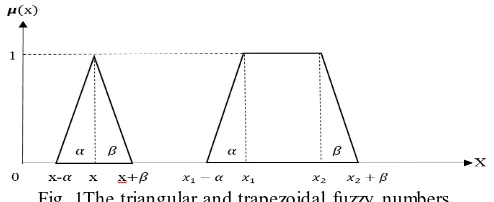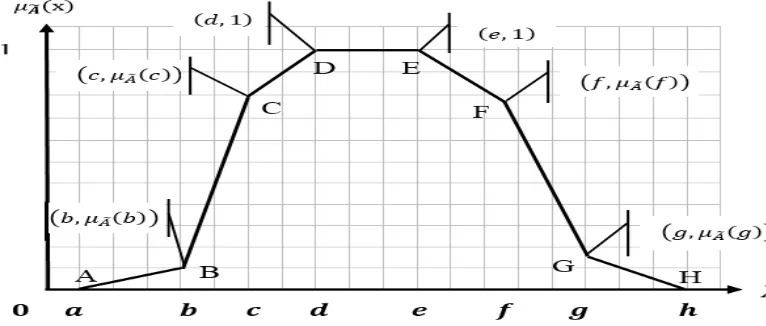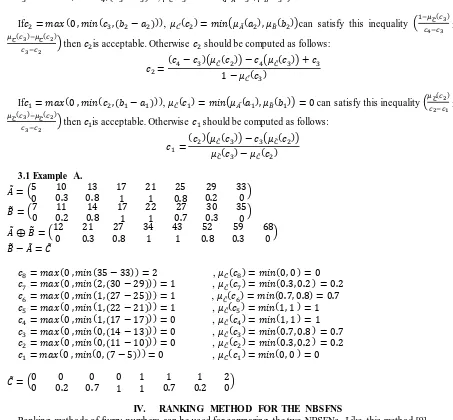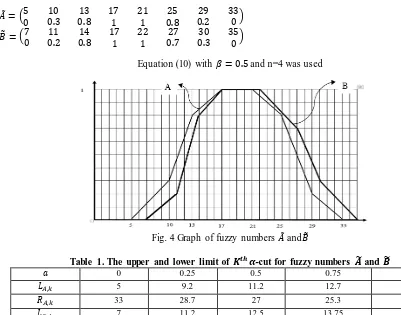A New Bell Shape Fuzzy Number
Navid Bagheri
#1,Seyed Saeid Hashemin
*2#1Department of Industrial Engineering, Ardabil Branch, Islamic Azad University, Ardabil, Iran . *2Department of Industrial Engineering, Ardabil Branch, Islamic Azad University, Ardabil, Iran.
1navid0001371@gmail.com
Corresponding Author: 2 s.s.hashemin@gmail.com
Abstract —Uncertainty can be expressed by fuzzy numbers. Some fuzzy numbers are triangular and trapezoidal. Although it is easy to perform calculations on them, they are not flexible enough to show the uncertainty. Bell shape fuzzy numbers are very flexible. However, it is very difficult to conduct arithmetic operations on them. In this paper, a new bell shape fuzzy number has been developed. The new fuzzy number look s lik e a bell . Then, arithmetic operations have been defined for the new fuzzy number. Also, it has been proven that the rank ing of the new fuzzy number can be done successfully. The above mentioned opera tions and the rank ing method o f t h e new fuzzy number have been described by some examples. The new fuzzy number is more flexible compared to triangular and trapezoidal ones. Also, arithmetic calculation of the new fuzzy number is much simpler than t h a t of a bell shape fuzzy number.
Keywor ds (Size 10 & Bold) —New fuzzy number, Bell shape fuzzy number, Operations on fuzzy numbers.
I. INTRO DUC TIO N
Before the advent of fuzzy set theory, researches used the random variables to describe the uncertainty. It is obvious that it is difficult to perform arithmetic operations on random variables. In addition, random variables cannot describe the all cases of uncertainty completely. So, Zade in 1965 introduced promising new horizons to different scientific areas. Fuzzy theory, with presuming imprecision in deciding parameters and utilizing mental models of experts, is a useful approach to adapt scheduling models into reality [1]. (it’s ok but read it again.)
In recent decades, trapezoidal fuzzy numbers have been used for describing uncertain parameters in engineering systems. In special cases, these numbers can be transformed to triangular fuzzy numbers. Although summation and subtraction can be performed on both numbers easily, they aren’t flexible enough to describe the uncertain parameters. However, some researchers have used the trapezoidal fuzzy numbers to describe activity durations in GERT-type Networks [2], [3] and Metagraphs [4], [5], [6], and [7].Although bell shape fuzzy numbers are very flexible, performing summation and subtraction on these numbers is challenging.
Therefore, in this paper, a new fuzzy number have been developed which is very similar to bell shape fuzzy number. The new fuzzy number is called new bell shape fuzzy number (NBSFN). In addition to being a flexible fuzzy number in describing the uncertainty, performing summation and subtraction on this number is much easier due to the way it is defined. Also, a method has been introduced for ranking the numbers. The above mentioned topics have been clarified more, through some examples.
II. A NEW BELL SHAPEFUZZY NUMB ER
The trapezoidal and triangular fuzzy numbers have been defined in reference [8].
Among the various types of fuzzy numbers, triangular and trapezoidal fuzzy numbers are the most important ones. They are especially useful in solving possibility mathematical programming problems.
The triangular fuzzy numbers can be denoted as X=(x, α, β) and Y=(y,r,δ), where x and y are the central values(𝜇𝑥(𝑥) = 1 𝑎𝑛𝑑 𝜇𝑟(𝑦) = 1), α and r are the left spreads, and β and δ are the right spreads (see figure 1).
Similarly, the trapezoidal fuzzy numbers can be denoted as𝑋 = (𝑥1𝑚, 𝑥2𝑚, 𝛼, 𝛽).
The newly proposed fuzzy number is similar to bell shape fuzzy number. The membership function of the new fuzzy number has eight parameters. a, b, c, d, e, f, g and h which show the parameters of the new fuzzy number such that 𝜇𝐴̃(𝑎) = 𝜇𝐴̃(ℎ) = 0 and 𝜇𝐴̃(𝑑) = 𝜇𝐴̃(𝑒) = 1.
Membership function of NBSFN is as follows:
𝜇𝒁̃(𝒙) =
{
0 𝑥 ≤ 𝑎 (𝜇𝐴̃(𝑏))(𝑥 − 𝑎)
𝑏 − 𝑎 𝑎 ≤ 𝑥 ≤ 𝑏 (𝑥 − 𝑏)(𝜇𝐴̃(𝑐)) + (𝑐 − 𝑥)(𝜇𝐴̃(𝑏))
𝑐 − 𝑏 𝑏 ≤ 𝑥 ≤ 𝑐 (𝑑 − 𝑥)(𝜇𝐴̃(𝑐)) + (𝑥 − 𝑐)
𝑑 − 𝑐 𝑐 ≤ 𝑥 ≤ 𝑑 1 𝑑 ≤ 𝑥 ≤ 𝑒 (𝑥 − 𝑒) (𝜇𝐴̃(𝑓)) + (𝑓 − 𝑥)
𝑓 − 𝑒 𝑒 ≤ 𝑥 ≤ 𝑓 (𝑥 − 𝑓)(𝜇𝐴̃(𝑔)) + (𝑔 − 𝑥)(𝜇𝐴̃(𝑓))
𝑔 − 𝑓 𝑓 ≤ 𝑥 ≤ 𝑔 (𝜇𝐴̃(𝑔))(ℎ − 𝑥)
ℎ − 𝑔 𝑔 ≤ 𝑥 ≤ ℎ 0 𝑥 ≥ ℎ
The shape of NBSFN has been shown in fig.2.
Fig. 2 The general figure of the new bell shape fuzzy number
It is obvious that 0 ≤ 𝑎 ≤ 𝑏 ≤ 𝑐 ≤ 𝑑 ≤ 𝑒 ≤ 𝑓 ≤ 𝑔 ≤ ℎ. There are some conditions related to membership function:
For points A, B, C and D:{
𝜇𝐴̃(𝑏) −0 𝑏−𝑎 ≤
𝜇𝐴̃(𝑐)−𝜇𝐴̃(𝑏) 𝑐−𝑏
1−𝜇𝐴̃(𝑐) 𝑑 −𝑐 ≤
𝜇𝐴̃(𝑐)−𝜇𝐴̃(𝑏) 𝑐−𝑏
(1)
(2)
For points E, F, G and H: {
𝜇𝐴̃(𝑓) −1 𝑓−𝑒 ≥
𝜇𝐴̃(𝑔)−𝜇𝐴̃(𝑓) 𝑔−𝑓
0−𝜇𝐴̃(𝑔) ℎ−𝑔 ≥
𝜇𝐴̃(𝑔)−𝜇𝐴̃(𝑓) 𝑔−𝑓
If
[
𝜇𝐴̃(𝑏) −0 𝑏−𝑎 =
𝜇𝐴̃(𝑐)−𝜇𝐴̃(𝑏)
𝑐−𝑏 =
1−𝜇𝐴̃(𝑐) 𝑑 −𝑐
𝑎𝑛𝑑
𝜇𝐴̃(𝑓)−1 𝑓−𝑒 =
𝜇𝐴̃(𝑔)−𝜇𝐴̃(𝑓)
𝑔−𝑓 =
0−𝜇𝐴̃(𝑔) ℎ−𝑔 ]
then NBSFN is transformed to a trapezoidal fuzzy number. It is evident
that trapezoidal fuzzy number is a special case of NBSFN.
The above mentioned inequalities make the shape of NBSFN similar to a bell.
For showing(𝑥, 𝜇𝐴̃(𝑥)), a matrix with 2 rows and 8 columns was used which is described as follows:
𝐴̃ = ( 𝑎0 𝜇𝑏
𝐴̃(𝑏)
𝑐 𝜇𝐴̃(𝑐)
𝑑 1
𝑒 1
𝑓 𝜇𝐴̃(𝑓)
𝜇 𝑔
𝐴̃(𝑔)
ℎ 0 )
III. ARITHMETIC OPERATIONS ON THENEW BELL SHAPE FUZZY NUMB ER
Suppose that 𝐴̃ and 𝐵̃ are two bell shape fuzzy numbers:
𝐴̃ = (𝑎01 𝜇 𝑎2
𝐴̃(𝑎2)
𝑎3
𝜇𝐴̃(𝑎3)
𝑎4
1 𝑎5
1 𝑎6
𝜇𝐴̃(𝑎6)
𝑎7
𝜇𝐴̃(𝑎7)
𝑎8
0) 𝐵̃ = (𝑏1
0 𝑏2
𝜇𝐵̃(𝑏2)
𝑏3
𝜇𝐵̃(𝑏3)
𝑏4
1 𝑏5
1 𝑏6
𝜇𝐵̃(𝑏6)
𝑏7
𝜇𝐵̃(𝑏7)
𝑏8
0)
Then sum of the two new bell shape fuzzy numbers can be computed as follows:
𝐴̃ ⊕ 𝐵̃ =
(𝑎1+ 𝑏1 0 ,
𝑎2+ 𝑏2 max {𝜇𝐴̃(𝑎2),𝜇𝐵̃(𝑏2)},
𝑎3+ 𝑏3
max {𝜇𝐴̃(𝑎3), 𝜇𝐵̃(𝑏3)}, 𝑎4+ 𝑏1 4 ,
𝑎5+ 𝑏5 1 ,
𝑎6+ 𝑏6 max {𝜇𝐴̃(𝑎6), 𝜇𝐵̃(𝑏6)},
𝑎7+ 𝑏7
max {𝜇𝐴̃(𝑎7),𝜇𝐵̃(𝑏7)},𝑎8+ 𝑏0 8)
A subtraction operator is defined for the two positive trapezoidal fuzzy numbers such that the subtraction of them is a positive trapezoidal fuzzy number [1].
By generalizing this operator to the new bell shape fuzzy numbers, subtraction of two NBSFNs will be a positive bell shape fuzzy number as follows:
𝐵̃ − 𝐴̃ = 𝐶̃ = ( 𝑐01 𝜇 𝑐2
𝐶̃(𝑐2)
𝑐3
𝜇𝐶̃(𝑐3)
𝑐4
1 𝑐5
1 𝑐6
𝜇𝐶̃(𝑐6)
𝑐7
𝜇𝐶̃(𝑐7)
𝑐8
0 ) 𝑐8= 𝑚𝑎𝑥(0 , 𝑚𝑖𝑛 (𝑏8− 𝑎8)), 𝜇𝐶̃(𝑐8) = 𝑚𝑖𝑛(𝜇𝐴̃(𝑎8), 𝜇𝐵̃(𝑏8)) = 0
𝑐7= 𝑚𝑎𝑥(0 , 𝑚𝑖𝑛 (𝑐8, (𝑏7− 𝑎))), 𝜇𝐶̃(𝑐7) = 𝑚𝑖𝑛 (𝜇𝐴̃(𝑎7), 𝜇𝐵̃(𝑏7))
If𝑐6= 𝑚𝑎𝑥 (0 , 𝑚𝑖𝑛 (𝑐7, (𝑏6− 𝑎6))), 𝜇𝐶̃(𝑐6) = 𝑚𝑖𝑛(𝜇𝐴̃(𝑎6), 𝜇𝐵̃(𝑏6))can satisfy this inequality ( −𝜇𝐶̃(𝑐7)
𝑐8−𝑐7 ≥ 𝜇𝐶̃(𝑐7)−𝜇𝐶̃(𝑐6)
𝑐7−𝑐6 ) then 𝑐6is acceptable. Otherwise 𝑐6 should be computed as follows:
𝑐6=
(𝑐8− 𝑐7)(𝜇𝐶̃(𝑐6)) − 𝑐8(𝜇𝐶̃(𝑐7))
−𝜇𝐶̃(𝑐7)
If𝑐5= 𝑚𝑎𝑥 (0 , 𝑚𝑖𝑛 (𝑐6, (𝑏5− 𝑎5))), 𝜇𝐶̃(𝑐5) = 𝑚𝑖𝑛(𝜇𝐴̃(𝑎5), 𝜇𝐵̃(𝑏5)) can satisfy this inequality ( 𝜇𝐶̃(𝑐6)−1
𝑐6−𝑐5 ≥ 𝜇𝐶̃(𝑐7)−𝜇𝐶̃(𝑐6)
𝑐7−𝑐6 ) then 𝑐5is acceptable. Otherwise 𝑐5 should be computed as follows:
𝑐5=
(𝑐7− 𝑐6) − 𝑐7(𝜇𝐶̃(𝑐6)) + 𝑐6(𝜇𝐶̃(𝑐7))
𝜇𝐶̃(𝑐7) − 𝜇𝐶̃(𝑐6)
𝑐4= 𝑚𝑎𝑥(0 , 𝑚𝑖𝑛 (𝑐5, (𝑏4− 𝑎4))), 𝜇𝐶̃(𝑐4) = 𝑚𝑖𝑛(𝜇𝐴̃(𝑎4), 𝜇𝐵̃(𝑏4))
(4)
(5)
(7)
𝑐3= 𝑚𝑎𝑥(0 , 𝑚𝑖𝑛 (𝑐4, (𝑏3− 𝑎3))), 𝜇𝐶̃(𝑐3) = 𝑚𝑖𝑛(𝜇𝐴̃(𝑎3), 𝜇𝐵̃(𝑏3))
If𝑐2= 𝑚𝑎𝑥 (0 , 𝑚𝑖𝑛 (𝑐3, (𝑏2− 𝑎2))), 𝜇𝐶̃(𝑐2) = 𝑚𝑖𝑛(𝜇𝐴̃(𝑎2), 𝜇𝐵̃(𝑏2))can satisfy this inequality ( 1−𝜇𝐶̃(𝑐3)
𝑐4−𝑐3 ≤ 𝜇𝐶̃(𝑐3)−𝜇𝐶̃(𝑐2)
𝑐3−𝑐2
) then 𝑐2is acceptable. Otherwise 𝑐2 should be computed as follows:
𝑐2=
(𝑐4− 𝑐3)(𝜇𝐶̃(𝑐2)) − 𝑐4(𝜇𝐶̃(𝑐3)) + 𝑐3
1 − 𝜇𝐶̃(𝑐3)
If𝑐1= 𝑚𝑎𝑥(0 , 𝑚𝑖𝑛(𝑐2, (𝑏1− 𝑎1))), 𝜇𝐶̃(𝑐1) = 𝑚𝑖𝑛(𝜇𝐴̃(𝑎1), 𝜇𝐵̃(𝑏1)) = 0 can satisfy this inequality ( 𝜇𝐶̃(𝑐2)
𝑐2−𝑐1≤ 𝜇𝐶̃(𝑐3)−𝜇𝐶̃(𝑐2)
𝑐3−𝑐2
) then 𝑐1is acceptable. Otherwise 𝑐1 should be computed as follows:
𝑐1=
(𝑐2)(𝜇𝐶̃(𝑐3)) − 𝑐3(𝜇𝐶̃(𝑐2))
𝜇𝐶̃(𝑐3) − 𝜇𝐶̃(𝑐2) 3.1 Example A.
𝐴̃ = (5 0
10 0.3
13 0.8
17 1
21 1
25 0.8
29 0.2
33 0) 𝐵̃ = (7
0 11 0.2
14 0.8
17 1
22 1
27 0.7
30 0.3
35 0) 𝐴̃ ⊕ 𝐵̃ = (12
0 21 0.3
27 0.8
34 1
43 1
52 0.8
59 0.3
68 0) 𝐵̃ − 𝐴̃ = 𝐶̃
𝑐8= 𝑚𝑎𝑥(0 , 𝑚𝑖𝑛 (35 − 33)) = 2 , 𝜇𝐶̃(𝑐8) = 𝑚𝑖𝑛(0, 0 ) = 0
𝑐7= 𝑚𝑎𝑥(0 , 𝑚𝑖𝑛 (2, (30 − 29))) = 1 , 𝜇𝐶̃(𝑐7) = 𝑚𝑖𝑛(0.3, 0.2 ) = 0.2
𝑐6= 𝑚𝑎𝑥(0 , 𝑚𝑖𝑛 (1, (27 − 25))) = 1 , 𝜇𝐶̃(𝑐6) = 𝑚𝑖𝑛(0.7, 0.8) = 0.7
𝑐5= 𝑚𝑎𝑥(0 , 𝑚𝑖𝑛 (1, (22 − 21))) = 1 , 𝜇𝐶̃(𝑐5) = 𝑚𝑖𝑛(1, 1 ) = 1
𝑐4= 𝑚𝑎𝑥(0 , 𝑚𝑖𝑛 (1, (17 − 17))) = 0 , 𝜇𝐶̃(𝑐4) = 𝑚𝑖𝑛(1, 1 ) = 1
𝑐3= 𝑚𝑎𝑥(0 , 𝑚𝑖𝑛 (0, (14 − 13))) = 0 , 𝜇𝐶̃(𝑐3) = 𝑚𝑖𝑛(0.7, 0.8 ) = 0.7
𝑐2= 𝑚𝑎𝑥(0 , 𝑚𝑖𝑛 (0, (11 − 10))) = 0 , 𝜇𝐶̃(𝑐2) = 𝑚𝑖𝑛(0.3, 0.2 ) = 0.2
𝑐1= 𝑚𝑎𝑥(0 , 𝑚𝑖𝑛(0, (7 − 5))) = 0 , 𝜇𝐶̃(𝑐1) = 𝑚𝑖𝑛(0, 0 ) = 0
𝐶̃ = (0 0
0 0.2
0 0.7
0 1
1 1
1 0.7
1 0.2
2 0)
IV. RANKING METHOD FOR THE NBSFNS
Ranking methods of fuzzy numbers can be used for comparing the two NBSFNs. Like this method [9]. Now, Chen-Lu method is described:
For a fuzzy number A, the 𝛼-cuts (level sets)𝐴𝑎 = {𝑥 ∈ 𝑅⎹𝜇𝐴(𝑥) ≥ 𝑎}, a∈ [0,1], are convex subsets of R. the
lower and upper limits of the K 𝛼-cut for the fuzzy number A are defined as:
𝑙𝑖,𝑘= 𝑖𝑛𝑓 {𝑥⎹𝜇𝐴(𝑥) ≥ 𝑎𝑘}, 𝑥 ∈ 𝑅
𝑟𝑖 ,𝑘 = 𝑠𝑢𝑝{𝑥⎹𝜇𝐴(𝑥) ≥ 𝑎𝑘}, 𝑥 ∈ 𝑅
Where 𝑙𝑖,𝑘 and 𝑟𝑖 ,𝑘are left and right spreads, respectively. While two fuzzy numbers 𝐴𝑖 and𝐴𝑗 are compared,
fig.3 illustrates their corresponding left and right spreads at 𝑎𝑘 level.
Fig. 3The left and right spreads of fuzzy numbers 𝐴𝑖 and 𝐴𝑗.
The left (right) dominance 𝐷𝑖,𝑗𝐿(𝐷𝑖,𝑗𝑅) of 𝐴𝑖 over 𝐴𝑗 is defined as the average difference of the left (right)
𝐷𝑖,𝑗𝐿 = 1
𝑛+1∑ (𝑙𝑖,𝑘− 𝑙𝑗,𝑘) 𝑛
𝑘=0
𝐷𝑖,𝑗𝑅 =
1
𝑛 + 1∑(𝑟𝑖,𝑘− 𝑟𝑗 ,𝑘)
𝑛
𝑘=0
Where n+1 𝛼-cuts are used to calculate the dominance. Let 𝑎𝑘 denote the K 𝛼-level, and 𝑎𝑘 = 𝑘 𝑛, 𝑘 ∈
{0,1, … , 𝑛}. Therefore, the distance between each two adjacent 𝛼-level is equal; 𝑎𝑘− 𝑎𝑘−1= 1
𝑛, 𝑘 ≥ 1.
The total dominance of 𝐴𝑖 over 𝐴𝑗 with the index of optimism β∈ [0,1] can be defined as the convex
combination of 𝐷𝑖,𝑗𝐿and 𝐷𝑖,𝑗𝑅by
𝐷𝑖,𝑗(𝛽) = 𝛽𝐷𝑖,𝑗𝑅 + (1 − 𝛽)𝐷𝑖,𝑗𝐿
= 𝛽 [ 1
𝑛 + 1∑(𝑟𝑖 ,𝑘− 𝑟𝑗,𝑘)
𝑛
𝑘=0
] + (1 − 𝛽) [ 1
𝑛 + 1∑(𝑙𝑖,𝑘− 𝑙𝑗,𝑘)
𝑛
𝑘=0
]
= 1
𝑛 + 1{[𝛽 ∑ 𝑟𝑖,𝑘+ (1 − 𝛽) ∑ 𝑙𝑖,𝑘
𝑛
𝑘=0 𝑛
𝑘=0
] − [𝛽 ∑ 𝑟𝑗,𝑘+ (1 − 𝛽) ∑ 𝑙𝑗,𝑘 𝑛
𝑘=0 𝑛
𝑘=0
]}
The above equation indicates that the total dominance is actually a comparison function.
A decision maker can rank a pair of fuzzy numbers, 𝐴𝑖 and 𝐴𝑗, using 𝐷𝑖,𝑗(𝛽) , based on the following rules:
(1) If𝐷𝑖,𝑗(𝛽) > 0, then 𝐴𝑖> 𝐴𝑗;
(2) If 𝐷𝑖,𝑗(𝛽) = 0, then𝐴𝑖= 𝐴𝑗; and
(3) If𝐷𝑖,𝑗(𝛽) < 0, then𝐴𝑖 < 𝐴𝑗;
4.1 Example B.
Fig.4 illustrates two new bell shape fuzzy numbers,
𝐴̃ = (5 0
10 0.3
13 0.8
17 1
21 1
25 0.8
29 0.2
33 0) 𝐵̃ = (7
0 11 0.2
14 0.8
17 1
22 1
27 0.7
30 0.3
35 0)
Equation (10) with 𝛽 = 0.5 and n=4 was used
Fig. 4 Graph of fuzzy numbers 𝐴̃ and𝐵̃
Table 1. The upper and lower limit of 𝑲𝒕𝒉𝜶-cut for fuzzy numbers 𝑨̃ and 𝑩̃
1 0.75
0.5 0.25
0
𝑎
17 12.7
11.2 9.2
5
𝐿𝐴,𝑘
21 25.3
27 28.7
33
𝑅𝐴,𝑘
17 13.75
12.5 11.2
7
𝐿𝐵,𝑘
22 26.2
28.5 30.8
35
𝑅𝐵,𝑘
(10) (9)
𝐷𝐴 ,𝐵𝐿 =
1
𝑛 + 1∑(𝑙𝐴,𝑘− 𝑙𝐵,𝑘)
𝑛
𝑘=0
=1
5((5 − 7) + (9.2 − 11.2) + (11.2 − 12.5) + (12.7 − 13.75) + (17 − 17)) = −1.37
𝐷𝐴 ,𝐵𝑅 =
1
𝑛 + 1∑(𝑟𝐴 ,𝑘− 𝑟𝐵,𝑘)
𝑛
𝑘=0
=1
5((33 − 35) + (28.7 − 30.8) + (27 − 28.5) + (25.3 − 26.2) + (21 − 22)) = −1.5 𝐷𝑖,𝑗(𝛽) = 𝛽𝐷𝑖,𝑗𝑅 + (1 − 𝛽)𝐷𝑖,𝑗𝐿
𝐷𝐴 ,𝐵(0.5) = 0.5(−1.5) + 0.5(−1.37) = −1.43
We conclude that: 𝐷𝐴 ,𝐵(0.5) < 0 ⇒ 𝐵̃ > 𝐴̃.
V. CONCLUSIONS AND RECOMENDATIONS
The NBSFN is more flexible than triangular and trapezoidal fuzzy numbers. The arithmetic calculations performed on NBSFNs are simpler than those performed on the already existing bell shape fuzzy numbers.
A. In the future, researchers can develop suitable operations to recognize the maximum and minimum of NBSFNs.
B. A method can be developed for fuzzification of the new fuzzy number.
In project planning and control, new bell shape fuzzy numbers can show activity durations. In addition, the forward and backward computations can be generalized for fuzzy metagraphs .
REFERENC ES
[1] Soltani, A. and Haji, R. A project scheduling method based on fuzzy theory, Journal of Industrial and Syst e m s E ngin e e ring, 1 ( 1) , 2007, 70-80.
[2] Hashemin, S. S. and Fatemi Ghomi, S.M. T. A hybrid method to find cumulative distribution function of completion tim e o f GE RT
networks. J Ind Eng Int, 1(1), 2005, 1-9.
[3] Hashemin, S. S. Fuzzy completion time for alternative stochastic networks. Journal of Industrial Engineering In te rna tion al, 6 ( 11) , 2010, 17-22.
[4] Hashemin, S. S. Constrained Resource Allocation in fuzzy Metagraph, 10th Iranian conference on fuzzy Systems, Sh a h id Be h e shti
University, 2010, 1-5.
[5] Hashemin, S. S. Constrained Renewable Resource Allocation in fuzzy Metagraphs via Min-Slack. International Jour n al o f A p plie d
Operational Research, 1(1), 2010, 7-17.
[6] Hashemin, S. S. T ime Cost Trade-Off in Uncertain Metagraphs with Trapezoidal Fuzzy Edge T ime. Annals of Fuzzy Logic and Fuzzy
System. 1(2), 2011, 117-127.
[7] Vahedi, H. and Hashemin, S. S. A New Method for Allocation of Constrained Non -Renewable Resource in Fuzzy Metagraphs.
International Journal of Industrial Engineering, 2(3), 2015, 14-19.
[8] Chen, L. H., and Lu, H. W. An approximate approach for ranking fuzzy numbers based on left and right domina nc e, I n ter na tion al
Journal of Computers and Mathematics with Applications, 41(12), 1589 -1602.



